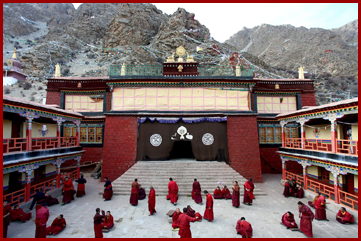Buddhism teaches that the sole aim of buddhas and bodhisattvas is to guide others to enlightenment. Since the time of the Buddha, countless bodhisattvas have perfected their training in compassion and skilful means and cared for their disciples wholeheartedly, but at the moment of passing away have had to leave the ongoing care of those disciples to others. However, once such great beings have reached a certain level of spiritual attainment, they have the ability to remain aware through the death process and consciously choose their next place of birth. This ability makes it possible for them to indicate the place of their next rebirth before they pass away, so that they can be clearly identified and thus resume the guidance of their students and their broader work in the world. This is the meaning of the term “reincarnate lama,” and Tibetan reincarnate lamas such as His Holiness the Dalai Lama and the Gyalwang Karmapa have engaged in this practice for over a dozen lives already. Yet for the first 15 centuries of the Buddhadharma, no master conceived of this ideal means of caring for their disciples life after life—until the First Karmapa, Dusum Khyenpa, with his extraordinarily creative means and his intense commitment to his students’ well-being and the continuity of the teachings entrusted to him.
Dusum Khyenpa was the first but by no means the last to identify himself to disciples as the reincarnation of their lama. Indeed, Tibetan Buddhism today would be vastly different without the reincarnation lineages of the many great masters who adopted this practice as a highly effective means of accomplishing a variety of beneficial aims.
Intentionally reincarnating in a form that disciples can recognize allows lamas to maintain long-term, multi-life relationships with their disciples. Although with each new birth, the lama must pass through the natural stages of physical development, they begin that process with a mental maturity far beyond their physical years. This allows them to quickly take up their role as a spiritual guide to their students from the previous life. By resuming relationships with such disciples, they guarantee that they are returning to the situation in which they have the strongest possible karmic and social basis to be of benefit to others. At the same time, they may continue any wider projects initiated in their previous lives, such as developing their monastic seats, study institutes or retreat centres and attend to the overall transmission of the teaching lineage under their care.
The unparalleled longevity of Buddhist institutions in Tibet is due in no small part to the remarkable resilience of such reincarnation lineages. Over the centuries, Tibetan Buddhism has survived wild fluctuations in political, military and economic conditions. In the 20th century, it managed to reconstitute itself in exile, bereft of all the material conditions that earlier sustained it in its native ground. Human beings have the capacity to adapt far more quickly than large institutions, and each new master in a reincarnation lineage may apply their wisdom and flexibility in response to changing historical circumstances, without losing the over-riding sense of purpose and direction that defines their lineage, and that led them to reincarnate in the first place. In this way, the institution of reincarnation has played a great part in allowing Tibetans to transmit the teachings brought from India over a millennium ago in unbroken lineages, and to cross back to India with that Dharma still a vitally relevant tradition.
What now seems so obvious a way to care for disciples and lineage over generations was not only not obvious in Dusum Khyenpa’s time: it was unheard of. In order to fully comprehend who the First Karmapa was, one would need to imagine so great a yearning for the wellbeing of the world, so firm a commitment to accomplish it himself, and so creative a thinker that he found a previously unimagined means of doing so.
Adapted from the book Karmapa: 900 Years.
Published in 2010 by the Karmapa 900 Organizing Committee.



